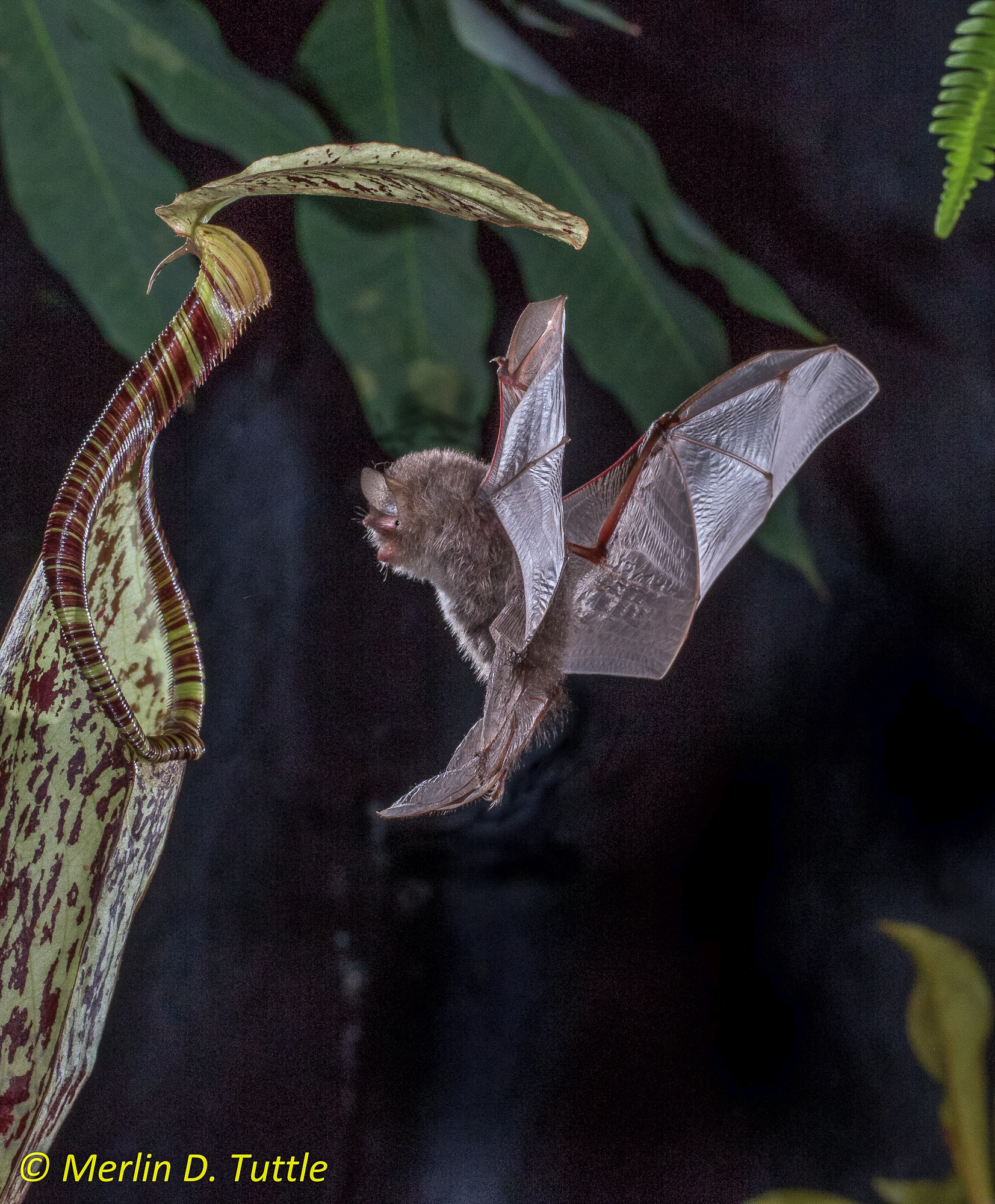Mutualisms, i.e. interspecific interactions that are beneficial for each of the interacting organisms, are common in nature. However, it is still unclear why these interactions maintain stable over millions of years despite the fact that the participating partners act selfishly. Whilst searching for answers to this question, the team around Dr. Michael Schöner and Dr. Caroline Schöner (Applied Zoology and Nature Conservation) found an aspect that has hardly been noticed so far in this context: the influence of traditions.
Due to earlier studies the researchers already knew that Hardwicke’s woolly bat had found a high-quality roost in the carnivorous pitcher plant Nepenthes hemsleyana on the Southeast Asian island of Borneo. The pitcher’s shape perfectly fits to the body size of the bats, they have a beneficial microclimate and because of an echo-reflecting structure the bats can easily find the pitchers. In return, the bats excrete their faeces in the pitchers while sleeping inside. These faeces have become such important nutrient sources for the plants that they have strongly adapted to the bats over the course of evolution.
However, the researchers also found the bats inside developing furled leaves of banana and ginger plants. Would that not therefore mean that the bats would be rather unreliable partners for Nepenthes hemsleyana? “We initially thought that Nepenthes hemsleyana’s quality as a roost is so high, that it simply outcompetes all other plants. This would mean that whenever the bats have the option to select, they should prefer Nepenthes hemsleyana”, says Dr. Michael Schöner. Hence, the researchers conducted experiments in which the bats could select between pitchers and furled leaves. In fact, bats, which the researchers had originally found in pitchers, always chose pitchers again in the experiments. Yet, in contrast to their prediction, bats that had been roosting in furled leaves in the wild, mostly chose furled leaves again, although 21% of bats from furled leaves switched to pitchers. “If we see similar behaviour of the bats in nature, the number of bats using pitchers instead of furled leaves will constantly increase”, explains Dr. Caroline Schöner.
But why are the bats so faithful to a roost, even if its quality is not optimal? To explain that behaviour, the researchers conducted genetic analyses. “First, we needed to find out if the bats’ different roosting behaviour derives from bat species that appear similar, but are actually different” says Prof. Gerald Kerth, the senior author of the study. However, the analyses showed that all tested bats belonged to the same species, irrespective of which roost they used. “We were also able to exclude all other potential explanations such as imprinting on a certain roost type”, summarizes Michael Schöner.
One strong assumption remained: All results indicated that a bat’s roosting behaviour is the consequence of different roosting traditions. This is evident because whole bat colonies choose different roost types in different areas. The bats used both pitcher plants and furled leaves only in one area, but intensive monitoring again showed that the individuals were faithful to only one roost type and never switched between pitchers and furled leaves. Moreover, the genetic analyses of bats from that area showed that individuals with the same roosting preference were more closely related with each other than with conspecifics that chose the other roost type. Finally, the fact that the juveniles stay for at least 77 days with their mothers is another strong indication for the existence of roosting traditions. Compared to other bat species, this is a very long period in a critical phase of a bat’s life. Within that period, the juveniles don’t just learn how to hunt from their mothers. “It is also likely that roosting behaviour is transmitted from the mothers to their young” assumes Caroline Schöner. Thus, if mothers transmit the use of Nepenthes hemsleyana, the interaction is stabilized. The researchers are currently planning further experiments to disentangle the influence of traditions on the bat-pitcher plant mutualism.
The study was funded by the German Research Council, the German Academic Exchange Service, and the Universities of Brunei Darussalam and Greifswald.
Further information
Original publication: Stabilization of a bat-pitcher plant mutualism. Michael G. Schöner1, Rebecca Ermisch1, Sébastien J. Puechmaille1, T. Ulmar Grafe2, Moi Chan Tan2 and Gerald Kerth1
Scientific Reports: www.nature.com/articles/s41598-017-13535-5
DOI10.1038/s41598-017-13535-5
Photo
The photo can be downloaded and used for free for editorial purposes in combination with this media release. The copyright owner of the photo must be named. Download
Corresponding author at the University of Greifswald
Applied Zoology and Nature Conservation
Zoological Institute and Museum
University of Greifswald
Loitzer Straße 26
17489 Greifswald
Tel.: +49 3834 420 4273
Fax: +49 3834 420 4252
schoenermuni-greifswaldde

